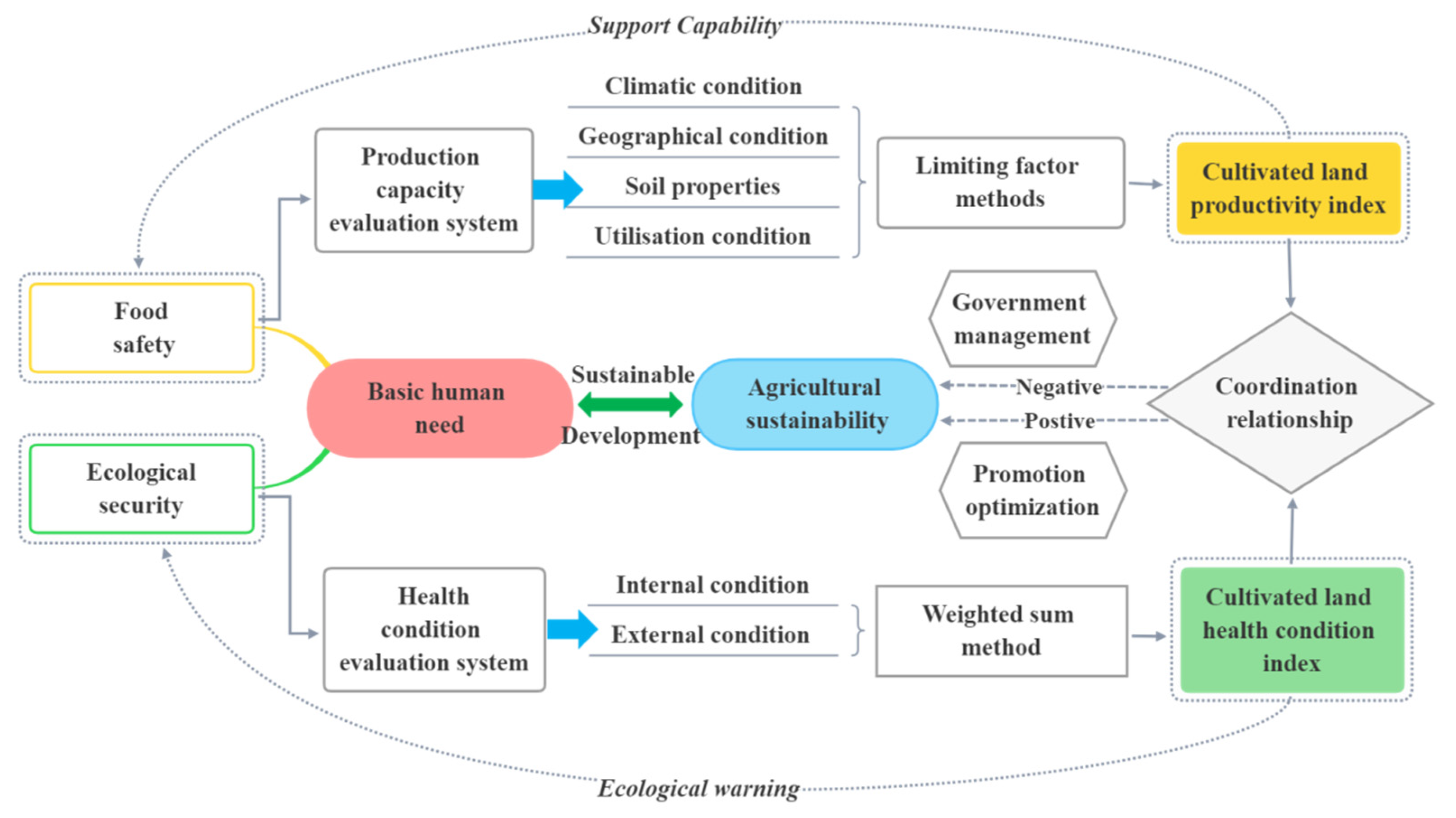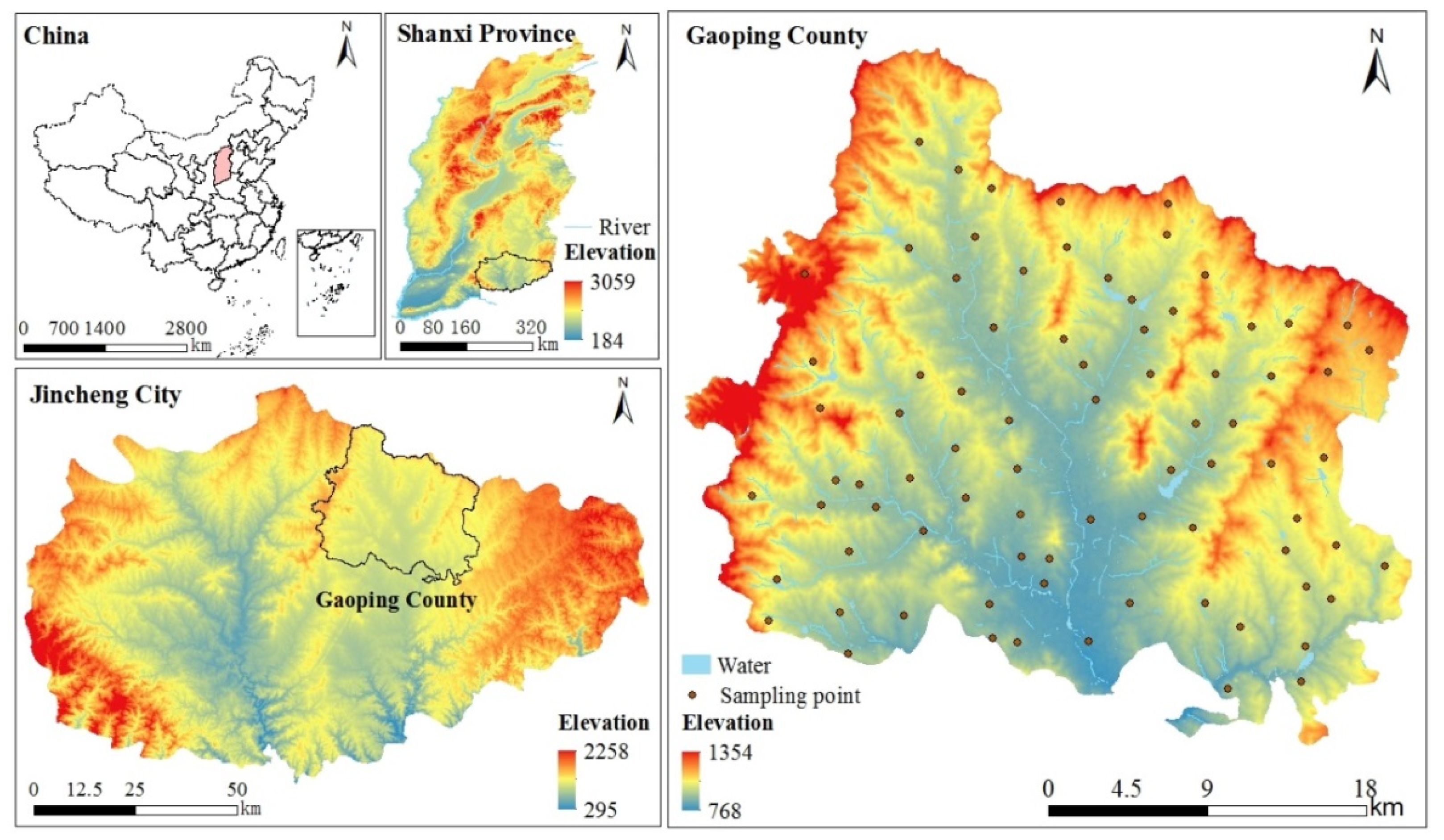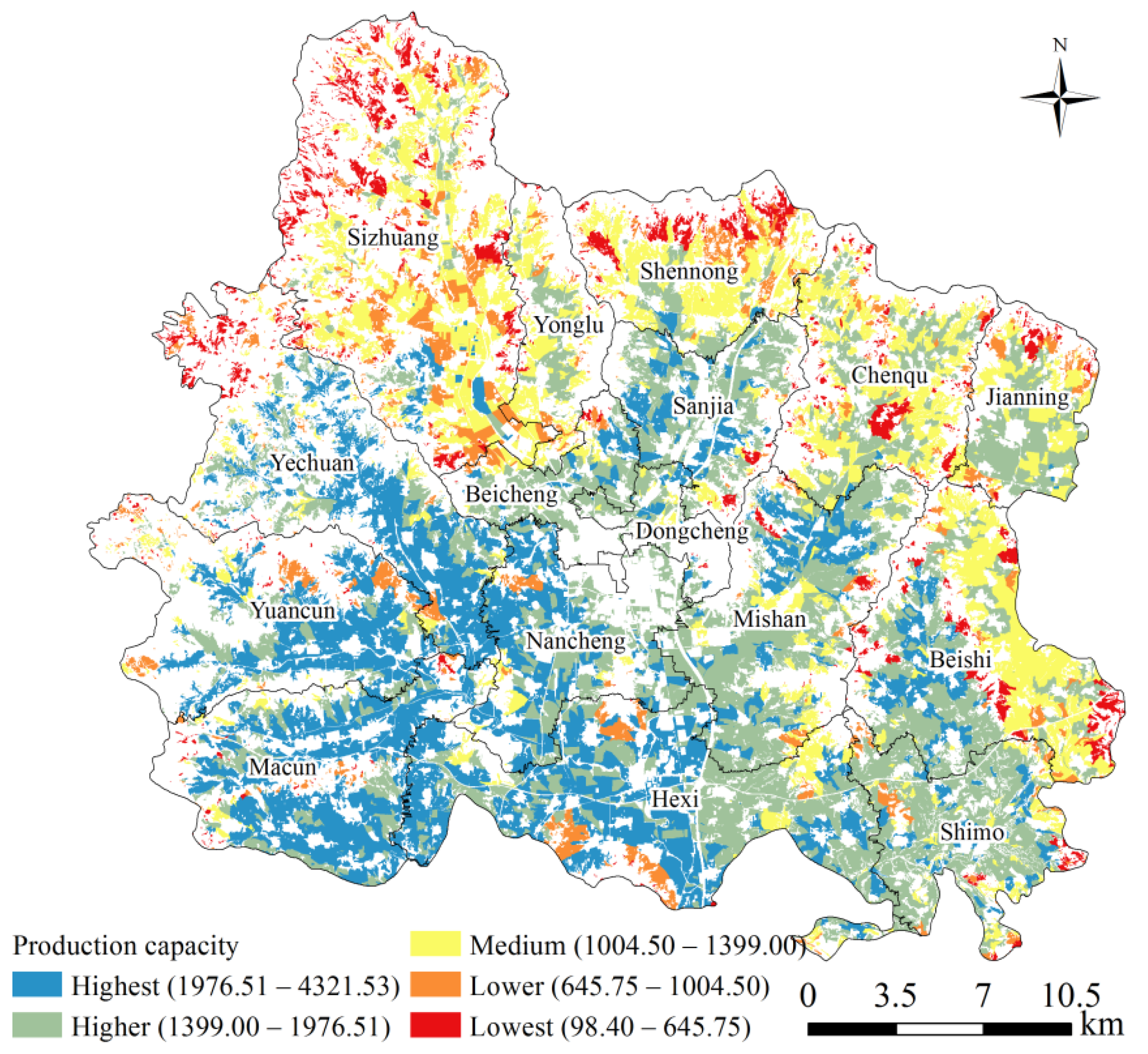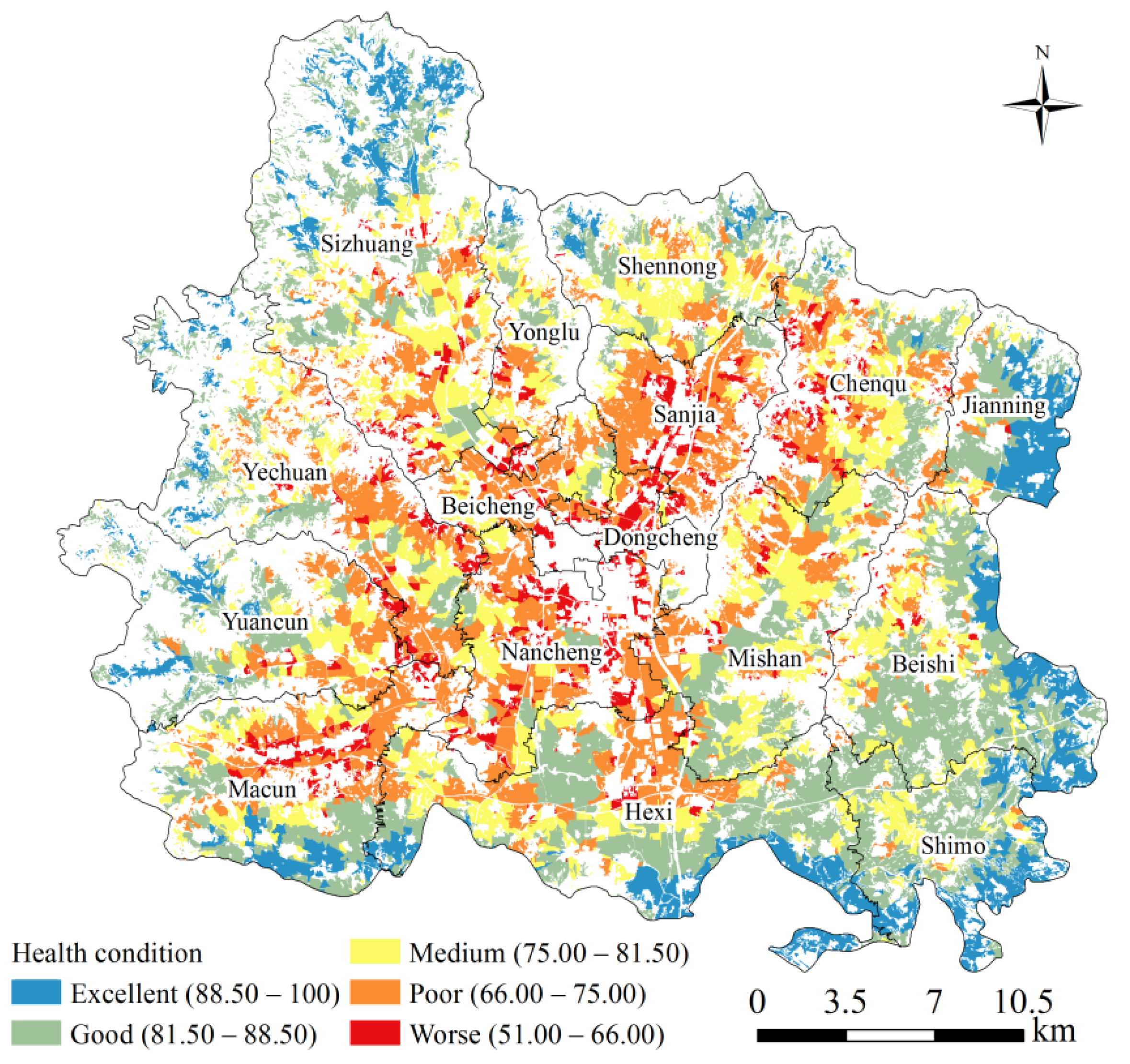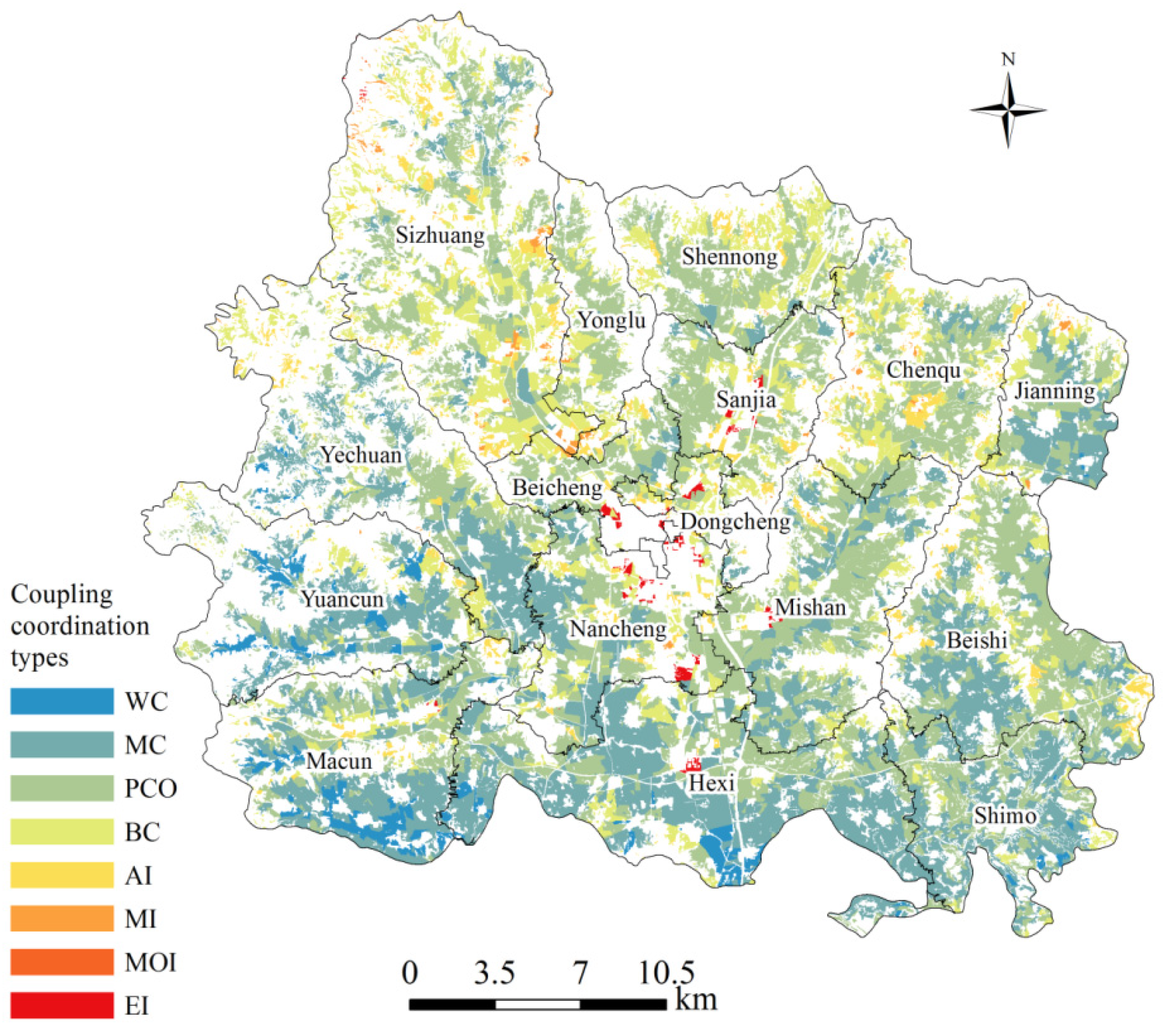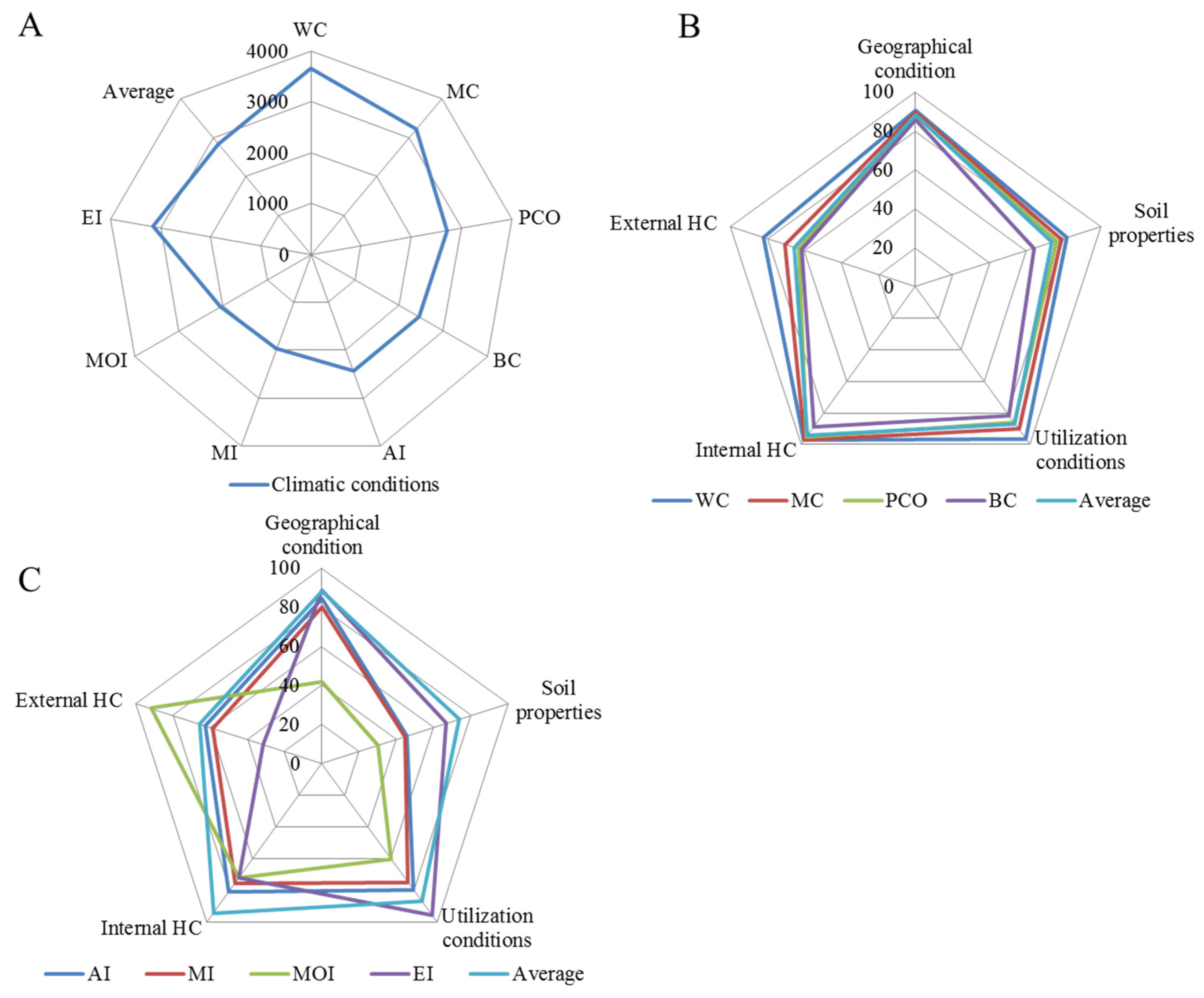1. Introduction
Cultivated land is the most valuable agricultural resources and production components [
1]. Accurate assessment of arable land production capacity (PC) is fundamental to guarantee national food security [
2,
3]. The health condition (HC) of cultivated land can describe the state of cropland ecosystems and is closely related to the sustainable use of cropland [
4,
5,
6]. As a traditional agricultural country, China’s food security is not only related to domestic food and clothing, and social order, but also affects the international food production environment [
7,
8]. China produces ~21% of the world’s food on 8% of the world’s agricultural land. The fertilization intensity is 2- to 3-fold higher than the global level [
9,
10]. Under long-term high load operation, cultivated land has reached the ecological threshold. More than 40% of arable land has been degraded, and a significant portion of the arable land has been contaminated [
11,
12]. Unsustainable land use practices have seriously threatened the food security and ecological security in China [
13]. Therefore, it is necessary to establish a system that can evaluate the PC and HC of cultivated land and to analyze their relationship to obtain key information for the sustainable development of cultivated land.
The methods to evaluate the PC of cultivated land can be divided into four categories: comprehensive index method, limiting factor method, combination of limited and non-limited factor synthesis method, and model method [
2,
14]. Among these methods, an increasing number of studies has confirmed that the limiting factor method can more accurately reflect the actual production [
15,
16]. Liu et al. conducted a practical study in China using the limiting factor method, which confirmed the feasibility and suggested this method could solve the problems of uniform evaluation results and inadequate spatial description experienced by the comprehensive index method [
14]. The traditional limiting factor method primarily considers the most limiting factors from the soil properties [
15,
17]; however, the productivity of cultivated land is affected by various factors (climate, topography, soil, and utilization factors) [
5,
18]. Therefore, in this study, we established a new framework to evaluate the PC, based on various factor types and using the limiting factor method.
With the increase of agricultural intensification, ecological problems such as soil erosion, pollution, and biodiversity loss are prominent. Agricultural activities have become the main cause of global environmental degradation [
19,
20], and protecting the HC of cultivated land is urgent. Cultivated land health evaluation systems can be divided into two categories [
14]: (1) Cornell Soil Health Evaluation System of the United States [
21], and (2) European Union Environmental Assessment of Soil for Monitoring Project [
22]. The Cornell system focuses on the internal environmental characteristics of the soil, and the EU’s system focuses on the external threats to cultivated land caused by human activities. However, the HC of cultivated land is not only related to internal ecological conditions such as soil properties and soil pollution but also to other ecosystems and the external environment [
23,
24]. Therefore, based on the principles of systemicity and integrity, the HC should comprehensively consider the condition both inside and outside the ecosystem.
The coupling coordination relationship represents the degree of harmony between the two systems in the development process and can reveal the succession rule between them [
25,
26]. In the process of exploring the relationship between human beings and nature, the coupling coordination model has been widely used [
27,
28]. However, there are few studies on the coupling relationship between PC and HC. For the sustainable development of cultivated land, considering the dynamic changes and spatial distributions of PC and HC separately is insufficient; the coupling and coordination relationship between the two systems is fundamental in revealing the status of cultivated land.
Therefore, we attempted to establish two systems: one to evaluate the PC by combining the limiting factor method and another to evaluate the HC based on internal and external health factors. The coupling coordination relationship between the production capacity index (PCI) and health condition index (HCI) was explored to provide a reference for the effective management of cultivated land.
3. Results
3.1. Cultivated Land Productivity
The comprehensive value of PC in Gaoping was 98.40–4321.53, and the average of the entire county was 1617.35, calculated using the area weighted average method. The natural breakpoint method was used to classify the PC into five levels (highest, higher, medium, lower, and lowest), and the spatial distribution condition was visualized using ArcGIS 10.3 (
Figure 3). Among the five levels, the higher-grade regions dominated, and the area was 19,419.78 ha, accounting for 36.37% of the total cultivated land. The highest and medium grade followed, which accounted for 29.14% and 22.00% of the total area of cultivated land, respectively. The lowest grade area was last with only 2826.31 ha, which accounted for 5.29% of the total cultivated land.
The spatial distribution of PC showed a gradual decrease from the southwest to northeast regions. The highest-grade areas were mainly distributed in the irrigated area in the western and south-central plains region (e.g., Hexi and Yuancun town). The higher-grade areas were mainly concentrated in the south plain area, including Hexi, Mishan, and Shimo. These regions had excellent environmental conditions for crop growth, such as abundant precipitation, suitable climate, and flat terrain. The arable land of medium grade was mainly distributed in the eastern and northern areas, including the townships of Yonglu, Beishi, and Chenqu. The lower-grade areas were mainly scattered in the northern region. Finally, the lowest grade arable land was mainly distributed in the northern edge area, where the terrain is high and mostly terraced, which is not suitable for crops. In general, the landforms change regional climatic and topographic conditions. The productivity of arable land is high in the plains, followed by the river valleys, and lowest in the mountainous northwest region. Meanwhile, factors such as soil texture, organic matter, and utilization conditions have a large impact on PC in local areas.
3.2. Cultivated Land Health Condition
The average score of the HC of arable land in Gaoping was 79.86. The natural breaks method was used to divide the HC into five levels;
Figure 4 shows the spatial distribution characteristics of each level. Overall, the HC score exhibited a low trend in the middle areas and high trend at the marginal region. There were obvious differences in the spatial distribution of different grades of arable land HC. Land of good grade accounted for the highest proportion (33.42%; 17,841.74 ha) of the total cultivated land. The good-grade land was scattered throughout the region but was mainly concentrated in the southeastern region, including Shimo and Beishi. This was followed by medium-grade land, which constituted 17,118.73 ha (32.06%) of the total cultivated land, which was mainly located at bands along the ridges of the central region. The cultivated land with the best ecological conditions was mainly distributed in the peripheral areas of the county. The complex terrain, distance from towns and cities, and the low human disturbance explained the high health quality. The poor and worse HC areas accounted for 16.98% and 5.27% of total cultivated land area, respectively; they are scattered throughout the entire region and are generally adjacent to urban residential areas.
This result is consistent with the urban layout, where health scores spread from low to high in a largely circular pattern. The lower scores were concentrated in both the central city and the settlement areas, where frequent human activity, the strong disturbance of arable systems by other ecosystems, the low probability of earthworm distribution, and the occurrence of heavy metal pollution are the main reasons for the poor or worse level of health of the arable land in these areas. In the marginal areas, although areas exist with low vegetation cover, these areas are less threatened by other ecosystems and have high habitat quality scores, along with a high earthworm distribution, combining to form the high score results. Generally, human activities strongly impact health conditions of cultivated land.
3.3. Coupling Coordination Relationship
There was a complicated mechanism between PC and HC. Healthy cultivated land was the foundation that supported productivity, and unhealthy cultivated land was often accompanied by land degradation and pollution. Excessive intensive use was an important contributor to the deterioration of HCs. Therefore, analyzing the spatial matching characteristics and coupling coordination relationship between PC and HC was beneficial to the differentiated protection and detailed management of the arable land, which was significant to the sustainable development of arable land.
The coupling coordination degree of PC and HC ranged between 0.05 and 0.895, with a mean value of 0.66, indicating that PC and HC were in the primary coordination stage in Gaoping City.
Figure 5 showed the spatial distribution characteristics of the coupling coordination degree. The coordination stage covered most of the area, and the WC, MC, and PCO were mainly concentrated in the southern region of Gaoping, while the imbalance stage was mainly distributed in the central and northern region. Coordination and imbalance transitioned through BC and AI stages, which were mainly distributed in the north-central region.
In the study region, the PCO, MC, and BC were dominant, accounting for 45.24%, 31.80%, and 15.36% of the cultivated land, respectively. There was no cultivated land with QC and SI stages in the entire city. The area shares of MI, MOI, and EI stages were all <1%, which were 260.48, 4.25, and 252.95 ha, respectively. Following this, the WC and AI accounted for 2.66% and 3.97%, respectively, and cover 3541.26 ha of the total cultivated land area.
The coupling coordination relationship of PC and HC varied widely in the administrative division of the town (
Table 7). The WC stage was mainly concentrated in Hexi, Macun, and Yuancun, accounting for 25.67%, 33.90%, and 32.00%, respectively. The MC stage had the largest area in Hexi town at 4155.44 ha, followed by Shimo and Yechuan at 2019.20 and 1946.59 ha, respectively. The BC and AI stages were mainly concentrated in Sizhuang town, accounting for 25.48% and 28.42%, respectively. Likewise, MI had the largest distribution in Sizhuang at 171.06 ha, and the MOI was only distributed in Sizhuang at 4.25 ha. The EI was mainly concentrated in the central region, which mainly included Beicheng, Nancheng, and Hexi towns.
5. Conclusions
In this study, we established an evaluation system of arable land productivity for four components (climate, landform, soil, and utilization) and evaluated the PC using the limiting factor method in Gaoping City. The evaluation results revealed that the average index of PC was 1617.35, and the higher-grade regions were dominant, with an area of 19,419.78 ha. An HC evaluation system including internal and external factors was constructed. The average score of the HC of arable land was 79.86. The HC score exhibited a low in the middle areas and a high trend at edge areas, indicating that human activities have a strong impact on health conditions. The coupling coordination relationship between PC and HC was analyzed, and the overall coupling coordination degree of PC and HC was at the primary coordination stage. The shortage factors affecting the coupling coordination relationship were analyzed to provide supporting information for sustainable cultivated land management.
